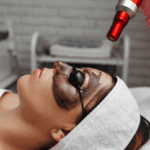Botox can treat conditions like migraines and is a popular cosmetic procedure for wrinkle reduction. No matter what you’re having this treatment, several essential botox aftercare practices will guarantee you receive the results you want.
When it comes to botox aftercare, it’s crucial to follow the advice of your med spa professional to ensure the best results and minimal side effects.
What Is Botox?
Botox refers to several botulinum toxin formulations. It’s also utilized in cosmetic medicine to relax muscles for a smoother, younger appearance.
Botox has uses in medical treatment for conditions like crossed eyes, heavy underarm sweating, eyelid spasms, spasticity in upper limbs, severe neck pain, and chronic migraine.
Facial wrinkles may be treated using Botox. The FDA only has approved it for use around the eyes and forehead, but it is typically used on the chin and mouth.
How Is A Botox Procedure Performed?
It’s advisable to avoid drinking alcohol for a week before your treatment. Additionally, you should avoid taking aspirin and anti-inflammatory medications for two weeks because this lessens the risk of bruising.
Botox is administered by dissolving a tiny portion of powdered botulinum toxin in saline. After cleaning, they’ll inject a thin needle, and this treatment requires no anesthesia.
To help the physician discover the injected muscles, you may be instructed to move them. Botox sessions usually last 10 minutes, but more significant areas may take longer.

Best Practices For Botox Aftercare For The Finest Outcome
Botox doesn’t produce quick results because it may take a few days before you get the result. Botox is minimally invasive and has little downtime. The botox aftercare might help the injections work more effectively.
1. Take It Easy On Yourself
Allow new injections to work. Intense activity, especially exercise, can transfer botox to unintended areas that reduce its effects. Wait four hours before doing any light exercise, such as jogging or mild yoga. Before you resume your regular workout routine, wait 24 hours.
2. Take The Pressure Off
After treatment, avoid touching the area for 1–3 days. Massages and tight garments or hats can dislodge injections. Avoid sleeping in afflicted areas if you can.
3. Reduce Overall Alcohol Intake
Before Botox, avoid alcohol, and wait 24 hours before drinking again. Anti-inflammatory alcohol thins the blood and causes bruising. Over-the-counter anti-inflammatories like ibuprofen are the same.
4. Give The Skin Some Rest
Using skincare that targets the same areas can remove Botox injections. For 24 hours, stay away from facials, exfoliating scrubs, and other procedures.
5. Keep Away From The Sun
Direct sunlight elevates blood pressure and flushes skin. This may induce bruising. Avoid sunlight for 48 hours after your treatment. Saunas, hot tubs, tanning beds, and hot baths are the same.
6. Take Your Doctor’s Instructions
Ask your doctor if there are other instructions you need to follow. Ask your doctor if any medications you are currently taking for unrelated problems could impact your Botox aftercare, for instance. Do this even though the medicine does not affect the injected areas.
Conclusion
Botox is safe if performed by an expert with training and expertise. Considering our best practices in botox aftercare, you could receive all of its benefits without bruising.


